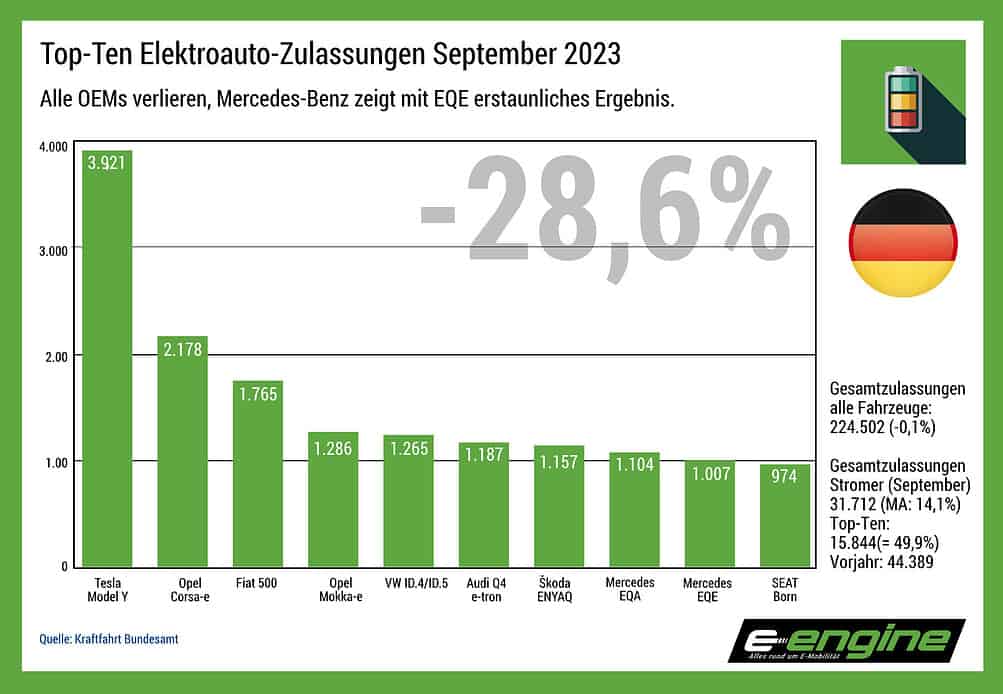
August 2023 marked a record for electric vehicle registrations in Germany. With an increase of 170.7 percent compared to the same month last year, electric vehicle registrations reached a 31.7 percent market share of total car registrations that month. The fan community rejoiced.
Only half the truth
Unfortunately, this was just a pep talk before September, which marked a turnaround that Habeck’s “traffic light” Ministry of Economics had already initiated shortly after taking office: starting in September 2023, only private buyers would be able to enjoy the government’s environmental bonuses. Commercial registrations would no longer receive any support with immediate effect.
The reason for this is obvious: the German state is also increasingly running into financial problems – not least due to the Ukraine war, the migration and energy crises.
September marked the moment of truth
So it was no wonder that the interested public eagerly awaited the Federal Motor Transport Authority (KBA) statistics. Would electromobility continue to grow without subsidies, as the fan community always assured?
Reality struck mercilessly
The hopes proved to be exaggerated. At least for September, because the slump hit hard. Minus 28.5% compared to the previous year’s result speaks a clear language. Of course, the August statistics were distorted because many commercial registrations were brought forward.
Private registrations are supposed to fix it
But what happened to private registrations? Here, a dichotomy crystallized. The biggest losers were all car suppliers in the 40,000-60,000 euro price range. This mainly affected the Koreans and some Chinese suppliers. Relatively constant were the luxury cars that already received little or no environmental bonuses, i.e. Porsche, Mercedes, and Co. Mercedes even significantly exceeded the previous year’s result – the EQE, by no means an inexpensive car, made it into the top ten.
OEMs with mixed offerings, such as BMW, suffered only minor losses.

Opel, PEUGEOT, and Co.
Some of the manufacturers of “inexpensive” electric cars made vehement gains. The Stellantis Opel and PEUGEOT brands, in particular, seemed better prepared for the changed market conditions. Some of the gains in a weak market environment were gigantic.
Does this mean that electromobility has already been written off again?
Of course not. In fact, the “e-motor” is currently faltering, not only because of the loss of bonuses, but also because of higher energy prices, which are burdening private households in particular.
However, the mass market conjured up by many electric car fans continues to be a long time coming. The prices of the supposedly “inexpensive” electric vehicles are still too high for the average consumer. Inexpensive electric vehicles with an acceptable range cost from 30,000 euros. In addition, the German economy is currently subject to an accelerating contraction process due to the abysmally bad industrial and economic policies of the “traffic lights.”
VW suffers most
VW, in particular, is affected by this. The ID series is roundly too expensive and offers too few incentives. Chinese OEMs offer more here but were unsuccessful in September because their entry prices were still quite sporty. This will probably change in the next few weeks because significant price reductions are possible with Chinese manufacturers, in contrast to German and European OEMs.
Currently, OEMs are still reacting cautiously and indirectly to the new situation. House prices are sometimes deeply below the recommended retail prices, MG Roewe even offers 30,000 free charging kilometers for certain models. And Citroën has just announced a Stromer for 23,300 euros BEFORE bonuses – with a comparatively large 44 kWh battery.
Glass ball reading
I expect a price war to come from the Chinese automakers. At the same time, the combustion engine will succeed in households that are under financial pressure, and will continue to do so until truly affordable electric vehicles with good ranges are offered. The used market for electric vehicles is still too young to expect big leaps here. The premium market will remain largely unaffected.
The biggest loser will be the VW brand, which is already struggling with a flat market environment and can hardly counter with lower prices because the prime costs of ID vehicles are too high compared with the competition from the Far East.
Nevertheless, the new market situation could have positive sides: OEMs must offer affordable electric cars to stay in the game. However, the Chinese suppliers currently have the best prerequisites for this. In contrast to the classic European OEMs, they react to changing market conditions at lightning speed.

